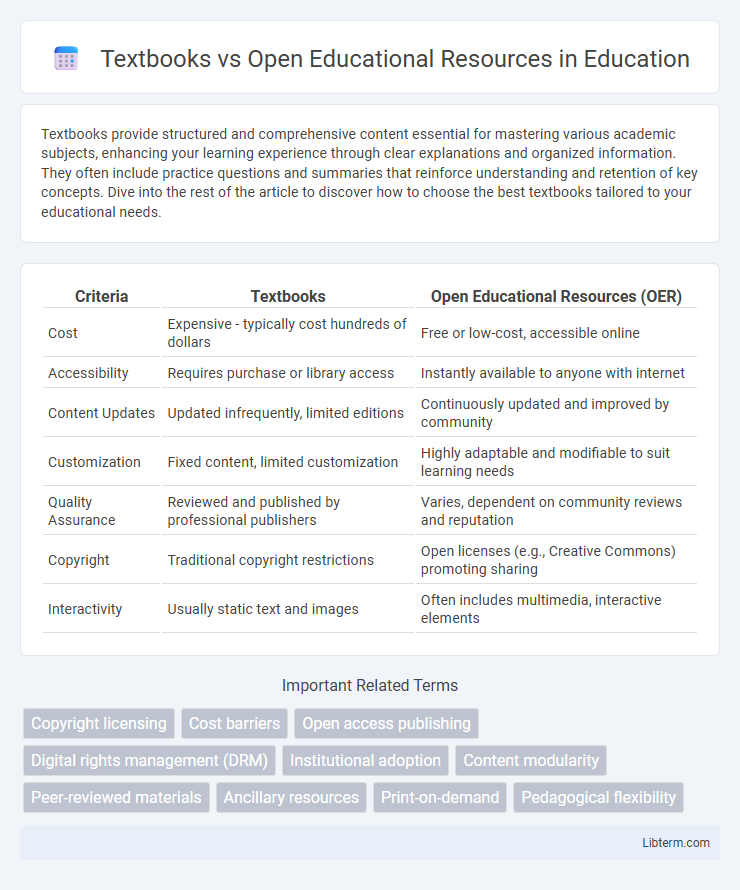Textbooks provide structured and comprehensive content essential for mastering various academic subjects, enhancing your learning experience through clear explanations and organized information. They often include practice questions and summaries that reinforce understanding and retention of key concepts. Dive into the rest of the article to discover how to choose the best textbooks tailored to your educational needs.
Table of Comparison
| Criteria | Textbooks | Open Educational Resources (OER) |
|---|---|---|
| Cost | Expensive - typically cost hundreds of dollars | Free or low-cost, accessible online |
| Accessibility | Requires purchase or library access | Instantly available to anyone with internet |
| Content Updates | Updated infrequently, limited editions | Continuously updated and improved by community |
| Customization | Fixed content, limited customization | Highly adaptable and modifiable to suit learning needs |
| Quality Assurance | Reviewed and published by professional publishers | Varies, dependent on community reviews and reputation |
| Copyright | Traditional copyright restrictions | Open licenses (e.g., Creative Commons) promoting sharing |
| Interactivity | Usually static text and images | Often includes multimedia, interactive elements |
Introduction: Navigating the Educational Content Landscape
Textbooks have long served as the primary source of structured educational content, offering curated and standardized material aligned with curriculum objectives. Open Educational Resources (OER) provide freely accessible, adaptable, and often collaborative alternatives that empower educators and learners to customize content to diverse needs. Navigating this landscape involves balancing the reliability and coherence of traditional textbooks with the flexibility and inclusivity of OER to enhance educational outcomes.
Defining Textbooks and Open Educational Resources (OER)
Textbooks are traditionally published educational materials, often costly and subject to frequent updates, designed to provide structured curriculum content. Open Educational Resources (OER) are freely accessible, openly licensed teaching, learning, and research materials that can be legally reused, revised, and shared to enhance educational equity. The distinction lies in OER's flexibility and cost-effectiveness compared to the fixed format and price of conventional textbooks.
Cost Comparison: Affordability for Students and Institutions
Textbooks typically cost between $80 and $300 per title, creating significant financial burdens for students and educational institutions. Open Educational Resources (OER) offer free or low-cost alternatives, reducing expenses without compromising educational quality. The adoption of OER can lower overall instructional costs by up to 90%, increasing affordability and accessibility across diverse academic programs.
Accessibility and Inclusivity of Learning Materials
Open Educational Resources (OER) significantly enhance accessibility by offering free, digital learning materials that can be easily modified to meet diverse student needs, including those with disabilities. Traditional textbooks often come with high costs and fixed content, limiting availability and customization for inclusive education. The adaptability of OER supports varied learning styles and promotes equity by reducing barriers related to economic and physical accessibility.
Quality and Reliability: Evaluating Educational Content
Textbooks typically undergo rigorous peer review and editorial processes ensuring high-quality, reliable content aligned with academic standards. Open Educational Resources (OER) offer diverse, up-to-date materials but vary in quality due to less standardized vetting procedures. Evaluating educational content requires assessing accuracy, relevance, and currency to determine its suitability for specific learning objectives.
Flexibility and Customization for Educators
Open Educational Resources (OER) offer unparalleled flexibility and customization for educators compared to traditional textbooks, allowing instructors to modify content to suit specific course objectives and student needs. Unlike fixed, costly textbooks, OER materials can be continuously updated, adapted, and integrated with multimedia elements, enhancing interactive and personalized learning experiences. This adaptability supports diverse teaching styles and evolving curricula, empowering educators to create dynamic and relevant educational content.
Legal and Licensing Differences
Textbooks often come with strict copyright restrictions limiting reproduction, distribution, and modification, requiring purchase for each user or institution. Open Educational Resources (OER) utilize licenses such as Creative Commons, allowing free use, adaptation, and sharing within legal boundaries set by the specific license type (e.g., CC BY, CC BY-SA). These licensing differences affect accessibility, cost, and flexibility in educational content deployment, promoting wider adoption of OER in various learning environments.
Impact on Student Learning Outcomes
Open Educational Resources (OER) enhance student learning outcomes by providing easy access to up-to-date, customizable content that supports diverse learning styles and promotes active engagement. Unlike traditional textbooks, OER reduce financial barriers, enabling students to interact more frequently with course materials and improve comprehension and retention rates. Studies indicate that the use of OER correlates with higher course completion rates and improved academic performance, demonstrating a positive impact on student achievement.
Long-term Sustainability and Evolving Education Needs
Open Educational Resources (OER) offer long-term sustainability by reducing costs and allowing continuous updates to reflect evolving education needs, unlike traditional textbooks that often become obsolete and require frequent repurchasing. Institutions embracing OER benefit from adaptable content that supports diverse learning styles and integrates emerging knowledge without licensing restrictions. Sustainable education ecosystems rely on OER's flexibility to maintain relevance and accessibility amid rapid technological and curricular changes.
Future Trends: The Role of OER in Modern Education
Open Educational Resources (OER) are rapidly transforming modern education by increasing accessibility and reducing costs compared to traditional textbooks, fostering more inclusive learning environments globally. Emerging technologies such as artificial intelligence and adaptive learning platforms are enhancing OER's customization and interactivity, driving future trends in personalized education. Institutions and policymakers increasingly support OER adoption to promote equity, innovation, and lifelong learning, positioning OER as a central element in the evolving educational landscape.
Textbooks Infographic

 libterm.com
libterm.com